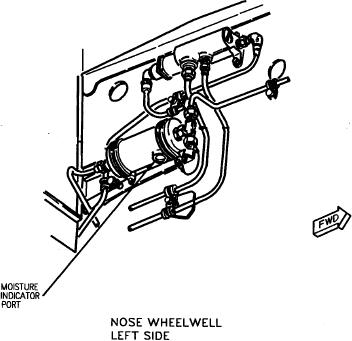
system of the weapon control system (WCS) and
Air Desiccators
missile. The temperature control system consists of a
There are two waveguide air desiccators in the
WCS cooling loop for the radar system and a missile
system. One is for ECM (fig. 5-26, item D) and one is
cooling loop for the missile system; both loops are
for radar (fig. 5-27). They are located downstream from
controlled by a common controller. In each loop, a
the waveguide fluid pressure regulating valves. The
motor-driven pump circulates a dielectric coolant fluid.
waveguide air desiccators contain a blue desiccant and
The fluid is filtered to remove air, moisture, and foreign
silica gel material, which absorbs moisture as airflow
matter. The right Phoenix missile fairing (fig. 5-28)
passes through the waveguide air desiccators. When the
contains the missile coolant pump assembly and the
desiccant and silica gel material becomes saturated
missile-air-moisture contaminant remover. When the
with moisture, the material color changes from blue to
missile cooling loop is not required, the fairing is
pink. The silica gel is visible through a moisture
removed from the aircraft. The ultimate heat sink is ram
indicator port on the housing of the waveguide air
air and/or refrigeration system air for cooling; hot air
desiccators.
from the bleed manifold 400F temperature control
system provides heating. The WCS/missile
Test Ports
temperature control system also uses cooling air from
the ground cooling system when ground operation is
The waveguide pressurization system has two test
required.
ports: one for ECM and one for radar. The test ports are
located downstream from the regulators and are used as
COMPONENTS
gauge connection points when testing system pressure.
Components of the missile liquid cooling system
OPERATION
include a cold and a hot air modulating valve, an
air-to-coolant heat exchanger, a coolant pump, a
The waveguide pressurization system provides
coolant fluid expansion tank, a bypass valve, an
regulated, filtered dry air to the ECM and radar
air-moisture-contaminant remover, a missile controller,
waveguide cavities. The waveguide fluid pressure
a coolant temperature sensor, a fairing interlock switch,
regulating valves controls this air pressure. Each
and a liquid cooling control panel.
waveguide fluid pressure regulating valve has an
indicator that pops out and vents downstream pressure
Missile Cold Air Modulating Valve
in excess of 4.3 psia. The indicator remains popped
until manually reset. The system functions
The cold air modulating valve (fig. 5-29) is
automatically whenever source air pressure (muscle
mounted on the air-to-coolant heat exchanger. The
pressure) is on.
Q5-38.
What is the purpose of an F-18 waveguide
pressurization system?
Q5-39.
What percentage of particles will the filter
assembly remove if they are 25 microns or
larger?
Q5-40.
The waveguide pressure regulating valve has
how many aneroid assemblies to regulate air
pressure?
MISSILE LIQUID COOLING SYSTEM
LEARNING OBJECTIVE: Identify the
operating principles and maintenance safety
precautions for the missile liquid cooling
utility system.
The missile liquid cooling system in the F-14
aircraft provides thermal conditioning for the radar
Figure 5-27.--Radar air desiccator.
5-24

